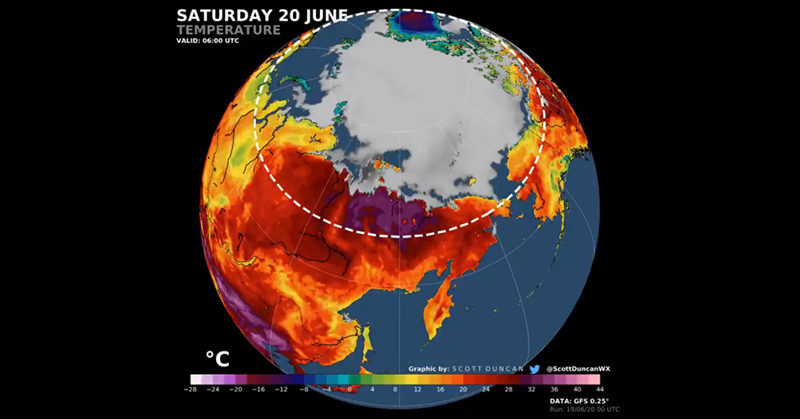The Earth’s poles have been an area of intense study for the past several years. The North and South Poles are the coolest climatic regions on the planet, and they affect the climate of everywhere else on Earth. For this reason, climatologists use the poles as a measuring stick to determine the state of the climate crisis [1]. Scientists are becoming increasingly concerned over an Arctic heat wave that has been occurring in Siberia.
Currently, things are not looking good.
An Arctic Heatwave
Verkhoyansk is a small Siberian town about 70 miles north of the Arctic Circle. On Saturday, June 20, temperatures in the town reached 100.4 degrees Fahrenheit. If this figure is verified, it will be the highest temperature reading that has ever been recorded in the region since scientists began keeping records in 1885 [2].
If confirmed, this reading will also be the northernmost 100 degree reading that has ever been recorded, and will break the record for the highest temperature on record in the Arctic.
The following day, temperatures in the region reached 95.3 degrees, which indicates that Saturday’s reading was not an anomaly. For comparison, for comparison, the average temperature in Verkhoyansk in June is 68 degrees [3].
Other Russian towns in the Arctic Circle have also been experiencing alarmingly high temperatures. Nizhnyaya Pesha reached 86 degrees on June 9, and Khatanga hit 77 degrees on May 22. Temperatures in Khatanga this time of year are usually around 32 degrees, and the previous heat record for the area was 53 degrees fahrenheit [4].
In May, surface temperatures in Siberia were 50 degrees Fahrenheit warmer than average, which is an alarming sign. Not only were May temperatures hotter than usual in the area, but temperatures were higher than normal throughout most of the winter and spring as well.
“Although the planet as a whole is warming, this isn’t happening evenly,” explained Freja Vamborg, a senior scientist at the Copernicus Climate Change Service (C3S). “Western Siberia stands out as a region that shows more of a warming trend with higher variations in temperature. So to some extent large temperature anomalies are not unexpected. However, what is unusual is how long the warmer-than-average anomalies have persisted for.” [4]
Russia as a whole has experienced record-high temperatures in 2020, with an average increase 1.9 degrees celsius (35 degrees fahrenheit). Although this doesn’t sound like much, it is actually quite significant and could have disastrous consequences [4].
Read: Evidence of 90-million-year-old rainforest uncovered beneath Antarctic ice
Could 2020 Be the Hottest Year on Record?
The temperatures at the Earth’s poles are rising faster than anywhere else because ocean currents carry heat towards them. Normally, the massive amounts of snow and ice located at either end of our planet reflect much of that heat, but as it continues to melt away, the areas are getting hotter and hotter [4].
Because of this, 2020 is shaping up to possibly be the hottest year on record for the entire planet. The US National Oceanic and Atmospheric Administration has estimated that there is a 75 percent chance that this year could be the hottest year since scientists began measuring global temperatures [5].
The agency has also calculated that there is a 99.9 percent chance that 2020 will be in the top five hottest years ever recorded [5].
What Does this Mean for the Planet?
We have already been seeing the effects of climate change for several years now, with severe weather becoming increasingly common and problematic all around the world. Russian President Vladimir Putin commented on the rising temperatures, stating that some of Russia’s cities were built on permafrost, and if that first melts it could have serious consequences for the people living there [4].
The thawing permafrost has been partly blamed for the diesel fuel spill that occurred in Siberia earlier this month, and high temperatures and high winds have exacerbated the wildfires that have been burning across significant portions of Siberia.
The increasing temperatures have also encouraged rapid growth of the Siberan Silk Moth population, which will have disastrous consequences for the forests in the area because their larvae eat at conifer trees [4].
These consequences are not unique to Siberia, and environments around the world are being affected by climate change. The wildfires in Australia at the beginning of the year are just one example of how rising global temperatures can destroy habitats and wipe out animals.
COVID 19: A Unique Opportunity
The main culprit for this increase in temperature is global CO2 emissions, which, because of the COVID-19 pandemic, will likely be lower this year. Karsten Haustein, a climate scientist at the University of Oxford, says that although the number of new emissions has been temporarily reduced, the build-up of greenhouse gasses in the atmosphere is still a major concern. The global shutdowns due to the coronavirus crisis do, however, provide us with an opportunity.
“We are very unlikely to be able to notice any slowdown in the built-up of atmospheric GHG levels,” he said. “But we have the unique chance now to reconsider our choices and use the corona crisis as a catalyst for more sustainable means of transport and energy production (via incentives, taxes, carbon prices etc).” [6]
Grahame Madge, a climate spokesman for the Met Office, agrees:
“A reliance and trust in science to inform action from governments and society to solve a global emergency are exactly the measures needed to seed in plans to solve the next crisis facing mankind: climate change.” [6]
- https://www.educapoles.org/multimedia/video_detail/what_is_the_point_of_studying_the_poles#:~:text=Well%2C%20it%20is%20important%20because,the%20ocean%20which%20surrounds%20it.
- https://www.commondreams.org/news/2020/06/22/scares-me-says-bill-mckibben-arctic-hits-1004degf-hottest-temperature-record
- https://www.washingtonpost.com/weather/2020/06/21/arctic-temperature-record-siberia/
- https://www.theguardian.com/environment/2020/jun/17/climate-crisis-alarm-at-record-breaking-heatwave-in-siberia
- https://www.ncdc.noaa.gov/sotc/global/202003/supplemental/page-2
- https://www.theguardian.com/environment/2020/apr/27/meteorologists-say-2020-on-course-to-be-hottest-year-since-records-began

